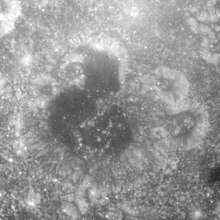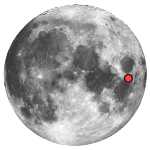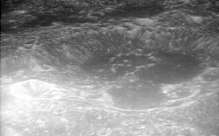Apollonius (crater)
Apollonius is a lunar impact crater located near the eastern limb of the Moon. It lies in the region of uplands to the west of Mare Undarum and northeast of the Sinus Successus on the Mare Fecunditatis. It was named after Greek mathematician Apollonius of Perga.[1] It is southwest of the crater Firmicus, and north of Condon.
 Apollo 15 image | |
| Coordinates | 4.5°N 61.1°E |
|---|---|
| Diameter | 53 km |
| Depth | 1.5 km |
| Colongitude | 299° at sunrise |
| Eponym | Apollonius of Perga |



The outer rim of Apollonius is somewhat worn and is overlain by a pair of small craters (including Apollonius E) across the western wall. The nearly flat interior floor has a low albedo and has been covered by lava. It lacks a central peak or notable small craters across the bottom.
Satellite craters
By convention these features are identified on lunar maps by placing the letter on the side of the crater midpoint that is closest to Apollonius.
| Apollonius | Latitude | Longitude | Diameter |
|---|---|---|---|
| A | 4.8° N | 56.8° E | 24 km |
| B | 5.7° N | 57.6° E | 32 km |
| E | 4.4° N | 61.9° E | 16 km |
| F | 5.6° N | 60.0° E | 16 km |
| H | 3.4° N | 59.6° E | 20 km |
| J | 4.6° N | 57.5° E | 12 km |
| L | 6.5° N | 54.6° E | 9 km |
| M | 4.8° N | 61.9° E | 10 km |
| N | 4.8° N | 64.1° E | 9 km |
| S | 1.1° N | 62.6° E | 15 km |
| U | 4.9° N | 59.9° E | 7 km |
| V | 4.4° N | 58.2° E | 16 km |
| X | 7.0° N | 58.1° E | 31 km |
| Y | 4.9° N | 62.6° E | 10 km |
The following craters have been renamed by the IAU.
- Apollonius C — See Ameghino (crater).
- Apollonius D — See Cartan (crater).
- Apollonius G — See Townley (crater).
- Apollonius K — See Abbot (crater).
- Apollonius P — See Daly (lunar crater).
- Apollonius T — See Bombelli (crater).
- Apollonius W — See Petit (crater).
.png) Apollonius N is a concentric crater
Apollonius N is a concentric crater Oblique view of Apollonius N from Apollo 17
Oblique view of Apollonius N from Apollo 17
References
- "Apollonius (crater)". Gazetteer of Planetary Nomenclature. USGS Astrogeology Research Program.
- Andersson, L. E.; Whitaker, E. A. (1982). NASA Catalogue of Lunar Nomenclature. NASA RP-1097.CS1 maint: ref=harv (link)
- Bussey, B.; Spudis, P. (2004). The Clementine Atlas of the Moon. New York: Cambridge University Press. ISBN 978-0-521-81528-4.CS1 maint: ref=harv (link)
- Cocks, Elijah E.; Cocks, Josiah C. (1995). Who's Who on the Moon: A Biographical Dictionary of Lunar Nomenclature. Tudor Publishers. ISBN 978-0-936389-27-1.CS1 maint: ref=harv (link)
- McDowell, Jonathan (July 15, 2007). "Lunar Nomenclature". Jonathan's Space Report. Retrieved 2007-10-24.CS1 maint: ref=harv (link)
- Menzel, D. H.; Minnaert, M.; Levin, B.; Dollfus, A.; Bell, B. (1971). "Report on Lunar Nomenclature by the Working Group of Commission 17 of the IAU". Space Science Reviews. 12 (2): 136–186. Bibcode:1971SSRv...12..136M. doi:10.1007/BF00171763.CS1 maint: ref=harv (link)
- Moore, Patrick (2001). On the Moon. Sterling Publishing Co. ISBN 978-0-304-35469-6.CS1 maint: ref=harv (link)
- Price, Fred W. (1988). The Moon Observer's Handbook. Cambridge University Press. ISBN 978-0-521-33500-3.CS1 maint: ref=harv (link)
- Rükl, Antonín (1990). Atlas of the Moon. Kalmbach Books. ISBN 978-0-913135-17-4.CS1 maint: ref=harv (link)
- Webb, Rev. T. W. (1962). Celestial Objects for Common Telescopes (6th revised ed.). Dover. ISBN 978-0-486-20917-3.CS1 maint: ref=harv (link)
- Whitaker, Ewen A. (1999). Mapping and Naming the Moon. Cambridge University Press. ISBN 978-0-521-62248-6.CS1 maint: ref=harv (link)
- Wlasuk, Peter T. (2000). Observing the Moon. Springer. ISBN 978-1-85233-193-1.CS1 maint: ref=harv (link)
External links
| Wikimedia Commons has media related to Apollonius (crater). |
- LTO-62C1 Firmicus — L&PI topographic map
